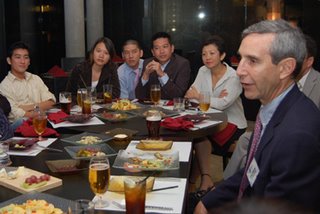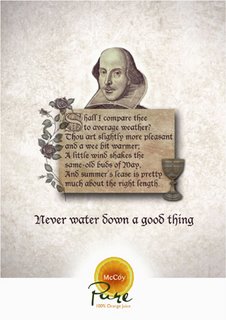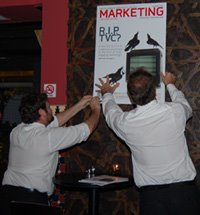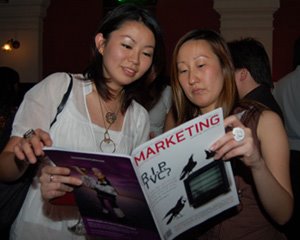Tuesday, October 31, 2006
The devil’s in the details
It may sound like a really simple concept but one which apparently eludes most marketers, why? It might just be that ensuring consistent branding isn’t easy considering all the minute details you have to pay attention to, or just a perception that certain functions are only meant to achieve the ‘functionality’ objective. I was talking to a brand consultant earlier today and he mentioned in passing that it was odd how many companies fork out huge sums of money to release a polished and sleek commercial which makes them look really good to customers. But when customers call into the company’s call centre or dial in to complete a telephone banking transaction, their idea and expectation of the brand (no doubt brought on by that nice commercial), and the reality of what they discover on the other end of the line can provoke a huge disappointment. “And that’s where the disconnect happens,” says the brand consultant. “What’s the use of spending so much money on the TV commercial then?”
The brand consultant also said marketers need to be cognisant of the changing environment around them, and to change with it. A phone banking system that’s five-years-old isn’t going to cut it with customers anymore -- many marketers probably only have the time to make sure that they have a system, but then don’t do anything to it or forget about it after some time. Is that still the right way of interacting with customers, can you ‘update’ the voice on the other end, put in some new music perhaps? Simplify and make the technology easier? Maybe marketers need to get out of the thinking mode where they think a function, like the company delivery guys, merely serve as a functionality when in fact, they’re are at the ‘frontline’ of your brand and have a strong influence on the image projected to customers. It’s a difficult situation: marketers are sometimes placed in a situation where they just have to get in there and do it, while these branding improvements take time to carry out and more often than not, is a long term effort. When there is space and time to take care of these areas though, I’ll bet it’ll pay off putting in place training programs for staff and ensuring all other consumer interactions are consistent with the overall branding, because having a keen eye for detail in your branding can be the key to what makes you stand out from your next competitor.
Friday, October 27, 2006
Death by blogging or eternal fame?
I’m kidding.
But seriously, Edelman hosted a very nice, cosy drinks session for a bunch of Singapore bloggers on Wednesday evening and it was quite insightful hearing the different perspectives on what kinds of pitches will bloggers tolerate.

By pitches, I mean that some marketers today view blogs as marketing tools through which they can get their brand messages across. Some lucky companies today have gained an enormous amount of publicity from their products/services getting reviewed on blogs and the news spreading like wildfire. Others have had to deal with the opposite kind of publicity.
Anyway, the aim of the session was for the PR company to get a better idea of how bloggers in Singapore think and operate and I’m going to try by best to give you my idea of a summary here.
Some of the attendees:
Richard Edelman and his team, Mr Brown, Joe Augustin, Adrian Lee, Bjorn Lee, Justin Lee,
Adrianna Tan, Jennifer Lewis from STOMP, The mediaslut.

So you’re a marketer and you want to get your new whatever famous overnight.
Here’s what to do:
1. Find a well-respected blogger such as Mr Brown and check out every single link he has on other people’s blogs. Birds of a feather flock together and bloggers worth their salt will link to other heavyweights they admire.
2. Read as many of their posts as you can to gain an idea of what they like or dislike.
3. Decide if what you’re pitching will interest each one. I don’t need to say this but if your product is crap there is no faster way to die than through blogs.
4. Find an innovative way to tell them about your ‘thing’. For example, Nokia gave Adrianna a phone with no strings attached except to say, “try it out”. She did, was blown away, and Nokia walked away with excellent PR value. But it was a risky move considering Adrianna was a Sony Ericsson fan.
5. The key is being innovative, and hard sell is NOT innovative. Remember, bloggers will only write what they have a strong opinion on, and their only opinion of your hard sell ways will be negative. Duh.
6. If the blogger writes positively about your ‘thing’, good. If your plan backfires, make sure you do not panic and sue the blogger’s pants off. Try to respond to backlash in a calm and measured manner and do not fan the fire with repeated, pronounced denials of wrongdoing. You may make things worse. Some situations do not even warrant a response from you.
7. If you want to invite a blogger to your press conference, he’ll go only if he’s interested in the topic/product, and you need to decide whether or not to categorise him as a Blogger or as Media. 8. Whatever you decide, please be decent to both types. (This point is for Mr Brown)
9. Joe Augustin (or was it Mr Brown) said it is important to remember that bloggers cannot be approached with the mindset that you’re ‘using’ them for commercial gain. Bloggers are people too you know, just like you and I.
I’d like to write more but I’ve got a press conference to attend.
In closing, I had a great time sharing thoughts with the group after the session and it was very refreshing meeting them face-to-face. I was also very honoured to be invited as a blogger as The Pitch has only been up for a few short months.
Thanks to the Edelman team for setting it up and it really shows how you guys are at the forefront of the digital communication wave and are willing to hear the views from the ground.
Monday, October 23, 2006
CSR=Cynical Scepticism Reaction?
Al’s the chairman and founder of GolinHarris and also the man who developed the concept of corporations having a ‘TrustBank’ – in a nutshell, this involves corporations doing ‘good work’ (and being seen to have done it) on a regular basis so that if ever the company gets involved in a sticky situation and the s*** hits the fan, you can mitigate the crisis by drawing from the bank of ‘good work’ you’ve done before.
I mean the philanthropy you see Bill Gates doing all the time seems well and good, but during my conversation with Al, I couldn’t resist asking him that really, aren’t these corporations carrying out CSR activities to contribute to a fatter bottom line, and not because they genuinely want to do it or sincerely think it’s good? In short, isn’t CSR for corporations a means to an end? Besides, even Al said CSR can act as a ‘tie breaker’ of sorts for companies – if they project an image of being trustworthy and reliable, more people would do business with them as they would rather deal with companies that they know, trust and admire than one that’s unknown.
Al didn’t miss a beat in his reply. He said, “Well, maybe it’s a bit of both, maybe it’s not all bad. Even if their motives are not as pure as it should be and they’re thinking of it from a business point of view, at least they’re doing something about it and getting it done. When you see Bill Gates and Warren Buffet give all this money to philanthropy, a cynic would say, well they’ve got all the money in the world, of course they’re going to give some of it away. Ok, it’s true, but at least they’re doing something about it, and something good is happening as a result of it. If they’re getting a good rub-off to their companies then why not? So I don’t think it’s a negative thing. If society is benefiting from it then it’s good.”
What do you think? Is CSR just a hypocritical myth for a shot at smiling for the cameras, or is there good underneath it all?
Thursday, October 19, 2006
Trade messages on mainstream media… what the?
An example is tonight’s Hall of Fame Awards which was advertised as a banner ad on soccernet.com, and on two walls at Raffles Link – our most celebrated creatives pose for the camera, representing the newly introduced creative director’s award for the HOF 2006.

Another example was the Singapore Media Awards which was advertised on radio and more.
The only people who are interested in award shows are agencies, who then rope in their clients for a “great night at a great table, with great company”, according to one of our blog watchers, thc. Thanks for your comments by the way.
Which is fair. I think award shows are great opportunities to reward creativity and having all your peers gathered together for a few evenings in a year is great. I, for one, love the atmosphere.
So why then, would running an ad on Class 95FM, for example, be of any use? Surely organisers can simply send an email to all the agencies in Singapore. There are only 300 plus of them and if that’s too many, then the usual suspects who are active at award shows are easy enough to identify and target.
One obvious reason why such ads appear on mainstream media is because parties such as SMRT Media are supporters of the award shows and it’s part of their partnership agreement to offer up some free ad space.
But I’m thinking, SMRT Media is a commercial organisation and it can make good money out of the space it’s giving away. I’m all for showing support of a worthy cause, but the support has to mean something.
I think it’s great SMRT Media is providing a platform for people our industry respect, such as Tay Guan Hin, Rob Gax, Ng Tian It etc., to come out from behind the scenes to be acknowledged for the work they do. But I don’t believe these names mean anything to the average MRT commuter, and he/she definitely won’t buy a table at the next award show.
My point is, trade messages in mainstream media does not make sense and there our media planners should know this much better than me.
I’m happy to be corrected on this.
Tuesday, October 17, 2006
High5: spot the difference?
IMSG has kindly provided me with the 'real' images of the High5 plant in Malaysia. I've also included the 'fake' images, so you guys can comment on what you think is real and what you think is fake or is it all fake?
Here we go...






One last picture for you guys, its a certificate stating High5 bread to be Halal.

Enough said from me, now its your turn to do the talking.
Monday, October 16, 2006
Advertising agencies are hypocrites
Dawn told me what he said months ago but the topic came up again recently while we were having tea with Eye Corp’s Raju Bahkta.
Let us ask this: how many ads for advertising agencies have you seen in the past six months? None?
We discussed how many agencies refuse to buy advertising, even though they make a business out of telling their clients advertising is good.
Some reasons (excuses) for not advertising include: no budget, no artwork, no time.
Could a reason for the lack of budget be because agencies spend everything submitting award entries, and then buy a gazillion tables at such shows?
Maybe the lack of artwork is a better excuse. I guess if I were a creative person I’d never be able to create something that represents me perfectly enough.
No time is just a cute one.
I respect that one honest soul who said his is a hypocritical business.
But I’m sure some other agency practitioners do not agree with the statement.
I’d like to hear what you have to say.
Thursday, October 12, 2006
Genius behind iPod ad comes out of the shadows
If you still don’t know who created that iconic iPod silhouette campaign that has become one of the most successful global campaigns ever, then you haven’t been reading our blog.

Tuesday, October 10, 2006
People power 2.0 not technology
Hynes was in Singapore for a one-day stopover and spoke to a select group of 13 CEOs and senior marketers at an event sponsored by Text 100 and hosted by Marketing magazine last evening. The event was held to give a small group of Singapore’s marketing elite (think Nike, BMW, Google, Jetstar, Bang and Olufsen and Philips just for starters) the opportunity to meet a genuine global leader in business communications.



“We’re living in the world of change – our people are changing and technology is enabling that change, and more tools are emerging in response to change,” Hynes says.
In line with her observation, Hynes started blogging earlier this year to be able to “understand what it feels like, what the considerations are”, so she can better advise clients on it. She feels anyone born before 1975 can be termed “digital immigrants”, while those born after are “digital natives” and thus the immigrants need to work harder to understand new communications tools.
She says no company should start by saying “we need a blog”; instead, it has to ask itself what it wants to achieve and if having a blog will be beneficial.
“With blogging, you’re going to attract attention and it may not all be welcome so you’ve got to understand it,” she says.
According to her, there are three issues surrounding the changing audience. The first is trust, ie. the erosion of institutional trust – people more likely to trust info coming from their peer groups.
Secondly, there’s media fragmentation – previously, we watched prime time TV and read the same newspapers; now, we get news from different places and we want news at our own time, in the format we prefer.
Lastly, people nowadays are empowered to create content and respond to views from others and so proximity between brand and customer is one to one – “the right of reply is immediate”, which leads to crisis management issues.
Under Hynes’s leadership, Text 100 has grown its position as a leader in global communications and is a thought partner for almost 300 clients across the world. She oversees annual revenues of US$60 million, a staff of over 500, and 30 offices spanning North America, Asia Pacific, and Europe. She is based in New York City and works directly with many of the company’s key accounts such as IBM, Xerox, Philips, and Fujifilm.
She recently over saw Text 100’s entry into Second Life, making it the first global PR firm to establish a presence inside the rapidly growing virtual world.
Monday, October 09, 2006
Crowing about the Crowbar Awards

(L-R: Anthony Kang, president of the 4As presenting the Overall Best of Show Award to a Media Design School, New Zealand team representative) (Overall Best of Show Award for'McCoys-Never water down a good thing' by Neil Williamson and Rachel Walker)
(Overall Best of Show Award for'McCoys-Never water down a good thing' by Neil Williamson and Rachel Walker)
I was outside the NTUC Auditorium around 6.45pm and had to take the glass lift up to the seventh floor, somehow I was able to stay calm even when I was staring right out the glass, my fear of heights disappeared as the smoky hazed sky totally blocked everything out.
When I reached the auditorium, I ‘checked in’ and got my ticket for the buffet and seating arrangement sorted out, was not hungry so I went to check out the entries on display. (Best of Category Gold for Film, 'Hollow' by Shi Ming Ming and Yang Lin from Nanyang Academy of Fine Arts)
(Best of Category Gold for Film, 'Hollow' by Shi Ming Ming and Yang Lin from Nanyang Academy of Fine Arts)
Once in the display area, I looked around for important marketers to photograph, so I could fill our November issue’s events page spread but at 7pm, there were mostly students just hanging around, showing off their work. I took some pictures of their work and overall I was impressed at the quality.
Now I waited for any ‘adults’ to show up so I could ask them, “Hey you’re not a student right? What are you doing here and where are you from? My name’s Marcus from Marketing magazine…blah blah blah, can I get a picture?” (Best of Category Gold for Photography, 'SKWIDD' by Cheong Meng Kwong, Ivan)
(Best of Category Gold for Photography, 'SKWIDD' by Cheong Meng Kwong, Ivan)
Hour’s later (ok maybe it was more like hour+++) I had a few good pictures and had continued my slow process of introducing myself to the industry as the new guy on Marketing’s block.
It started getting late so I went to take my seat which was right at the front and next to Carissa or was it Clarissa (didn’t catch her last name) and after chatting with her she told me that she was the host and I should get comfortable because it might be a long show. Oh well, I guess I should have eaten something at the buffet after all, at least the seats were comfortable though.
A couple of good speeches later, namely by Calvin Soh and Farrokh Madon, who are co-chairmen of this year’s Crowbar Awards, the celebration of the work began.
As with the norm of all award shows, there were too many awards but the host kept things lively enough and I can honestly say most of the work was of a high quality so a bronze for this and a bronze for that could be well deserved acknowledgement in retrospect.
Aside from the quality work I was also expecting to see more attitude and character on stage especially after Calvin Soh’s speech about swagger etc, and the fact that these are creative students here tonight. I kept on imagining a guy with a Mohawk running on stage, celebrating his victory with yelling and screaming and punches in the air. That guy never showed up…I guess he failed his copywriting class.
Thursday, October 05, 2006
Another round of sangria for the team please!
We’ve been around for 4.5 years now and it’s high time we rewarded our loyal readers with a refreshed product with improved content, easier navigation, a more attractive layout, a more modern feel and vibrant colours to match.
So we pooled our resources and planned for about three months, spent about three weeks intensively putting the content and design together, and it all culminated in a bash last night where we unveiled a very very very hot looking magazine.
 No, no no, it should be further left!
No, no no, it should be further left!
About 120 of you clicked glasses with us and shared feedback on the new look which we are very grateful for. I have to say that a few people whom we really wanted to party with did not receive our email invites (technology will let you down, it’s Murphy’s Law) and I’m sorry about that, and we wish you were there.


 The Lighthouse ladies
The Lighthouse ladies
Kudos to my team for the excellent work… it was great learning for all of us eh!

Hey bosses, may we have the rest of the month off? Pretty please?
(Confidential) Guess who don't sue, the joke's on us:
- Did you get a glimpse of Lighthouse’s very own New Paper beauty queen Jacqueline Thibodeaux? From what I noticed, a few members of the opposite sex kept her in close sight all evening.
- Which Marketing mag ace ad sales person had her mother call the office this morning on her behalf as she was hung over and had to stay home?
- Which (same) sales person stayed at the party till 3.30am and kept falling down stairs?
- Which (two) Lighthouse bosses were telling old-man stories towards the end of the night as a result of their getting over-familiar with the sangria?
- Which (two) Lighthouse colleagues showed up at work today in the same glamourous outfits they wore last night?
- Which Lighthouse ad sales person puked into her handbag at Bugis MRT station this morning?
- Which Lighthouse editorial person, also under the effects of sangria, thought she was a diva and kept making dramatic poses all evening?
If you’re wondering why we’re sharing such embarrassing happenings in such a public space, we say, “Come on, share a laugh with us!”
Wednesday, October 04, 2006
It’s not enough to satisfy your customers
Guess what? These days it’s not enough to ensure customer satisfaction – if you want loyal customers (read: higher profit margins), you’ve also got to make sure you appeal to their rational and emotional levels.
At least that was the message of a breakfast briefing organised by market research firms Harris Interactive and Market Share.
According to a study they did, customer loyalty can be nurtured through building trust together with satisfaction – in a nutshell, if companies can get customers to trust them and believe that the product they’re paying for is value for money, this creates an emotional connection between customers and brands, thereby increasing the level of commitment. This trust-based commitment then has the potential to translate into monetary returns for companies, as these consumers are more price-insensitive. This means even if you raise prices, they’ll still buy your product(s).
(Ok, I know you can't really see the above diagram but that's the best I've got.) There’s a lot more to the study but this is the fundamental point. I could be wrong but at the briefing, it seemed as though the hosts were delivering their new findings to a slightly skeptical crowd and it was easy to see why as the concept of customer satisfaction has been central to the marketing research community for a long time. During the Q&A session for instance, one participant questioned the disconnect between trust and satisfaction, while another raised the issue of the risk of basing a business model on trust, because once broken, is something that is very hard to repair.
The briefing facilitators though handled the queries well – with the first question it was explained that there’s no disconnect at all as trust was merged together with the old customer satisfaction model; all the study did was to uncover the element and stretch the pic. As for the risk of trust, it might be a case of consumers being more willing to forgive secondary mistakes, and allowing the brand a second chance at redeeming itself.
As a marketer, what do you think? Does trust have a place in your strategy?
Monday, October 02, 2006
Tell me the future for a piece of toast

The “future of communications in a connected world” that was the intriguing tag line that got me to attend Text 100’s recent breakfast briefing, the other reason I went? Free breakfast of course.
The talk happened about a week ago and leading the discussion was Georg Kolb, EVP for Text 100 New York and member of its executive leadership team. It was at a cosy little venue and so I went there at 8.45am optimistic about breakfast and actually very keen to hear what the “future of communications” was going to be; my mind still buzzing from the short video Text 100 sent us as part of the invite: (http://www.albinoblacksheep.com/flash/epic ).
If you have the time (it’s about five minutes long) watch it. It will get your taste buds set for the topic especially for those of you involved in a print publication which has online ambitions.
Back at the Text 100 briefing, I met a handful of people but I also managed to meet Georg Kolb and we started chatting about the topic and I tried to steer it towards a more Singapore or at least Asian perspective.
Off the top of my head I remember him saying the future of communications is about peer to peer platforms and he wished Singaporeans would think of peer to peer platforms beyond just blogs because they are so many other forms out there.
In fairness to those of us who do think this way, blogs are an obvious peer to peer platform to mention, for example if you took the time to view the short video which I recommended, well then that says a little something about the potential power of this peer to peer platform. Below are some links to blogs which were successful in using this peer to peer platform in the corporate world.
(IBM Corporate Blogging Programme) http://www-03.ibm.com/developerworks/blogs/
(Stonyfield Farm) http://www.stonyfield.com/weblog/
An example of a blog which was unsuccessful and has since been shut was one by Mazda. To enlighten yourself Google terms like Mazda Viral Marketing or Mazda Kid Halloween to find out more.
Kolb said in the briefing, “It’s about building peer referrals, people are empowered to find their peers and talk to them. People will no longer listen to a brand spokesperson who is always looking to push the brand; instead they are looking for a two way communication which will allow them to tell you what they think of the brand”.
Examples of the peer to peer platforms Kolb talks about include social networks (like MySpace), search engines and virtual life platforms, specifically Second Life. For those of you unfamiliar with Second Life, it is a virtual world on the internet where users, who are represented by 3D figures or avatars, can do everything from running businesses to having sexual liaisons.

At the briefing the importance of Second Life was debated and I got the impression not all were convinced the platform offered anything new, other than 3D imagery. Personally I think from the point of view of an internet user who sometimes struggles to keep up with the early adopters of today, it looks fantastic but how does it rate as a peer to peer platform? What is its Unique Selling Proposition to advertisers?
So as we come to the end of my blog entry, we are left with more questions than answers. I want to know, what my peers think the future of communications in a connected world is?
Hopefully not all of you will have read this entry and thought “what a load of crap I can’t believe I just wasted ten minutes of my life reading this, ten minutes which I will never get back, I hate you The Pitch and I hate you cruel connected world!”
That’s fine if you do though because we totally appreciate the way online works, and are prepared to get the criticism and praise which can come with a blog.